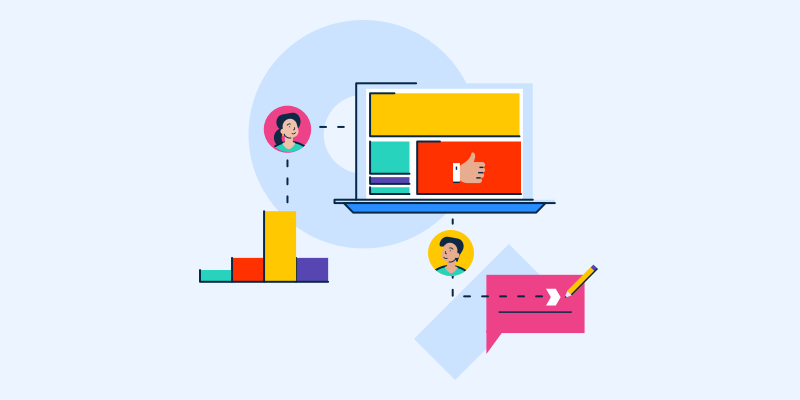What is intent data?
Intent data is a dataset that discloses a specific individual’s interests and predicts their expected next steps in the purchasing process. It’s a type of sales intelligence collected from a user’s behavior, usually from the content they consume on the web, that reveals insights into their likes and dislikes.
From a business perspective, intent data informs a brand when buyers are researching a product or solution, and which products or services they’re drawn to, all based on where and how they spend their time online. Sales and market leaders harness intent data to better understand which prospects are ready to buy.
Companies often use buyer intent data tools to collect insights into customers’ and prospects’ attraction to specific brands. These tools can capture research around the buyer’s journey and signs of their plans to purchase.
Types of intent data
Intent data falls into two different categories:
- First-party intent data is information collected about a company’s audience or customers. Sometimes called internal intent data, this can comprise data from CRM software, information from a brand’s social media efforts, surveys or forms sent directly to customers, and behavioral data and actions. It can be tracked using analytics tools, marketing automation software, or simply the backend of a company’s website.
- Third-party intent data refers to information that comes from outside sources, providing a border view of intent. Sometimes called external intent data, it may originate from apps that track actions and interests, cooperative publishers, or real-time bidding efforts of programmatic advertising. Most of this data is collected before a buyer even reaches a company’s website.
Benefits of intent data
Brands of all shapes and sizes experience many advantages from using intent signals. Some are:
- Learn more about the digital audience. Companies learn more about their audience because intent data pinpoints prospective buyers and which solutions they're actively researching.
- Understand the buyer at the start of their journey. Today's business-to-business (B2B) customers research online. Predictive intent data centered around purchasing makes it possible for sales and marketing teams to initiate contact with buyers early in the buying cycle. The sooner a company engages with a buyer, the better.
- Find more leads. Intent data signals alert businesses when buyers look for information about their specific product or service – even if those interactions don’t happen on that company’s website. Sales and marketing teams can then use this data to reach out to those potential leads with relevant content.
- Perfect the timing. Even though buyers aren't always ready to make a purchase, intent data provides insights into when prospects are in the research stage of the buying journey. This helps companies know when the time is right to engage, educate, and ultimately close a prospective account.
- Nurture leads through personalizing email leads. Intent data details which accounts are researching a brand and other topics they’re interested in. This makes for better and more customized nurture campaigns in their inbox.a
- Reduce churn. Retaining customers is less expensive than finding new ones. Intent data makes it possible to see what current clients are searching for and other solutions they may be considering. This offers insights into the competition's features and which alternative solutions are the most common. It’s up to the company to use this information to improve customer service efforts and reduce the risk of churn.
- Enhance account-based marketing (ABM). Intent data results in personalized and targeted ABM, which marketing and sales teams use to identify which targeted accounts are shopping for or researching products and services. This data can also help tailor messaging and resources to address pain points for specific accounts.
- Help with website optimization. Intent data assists ensure a company’s website meets its target audience's needs, including making changes to the navigation menu or design and creating landing pages tailored to specific needs.
Common sources of intent data
Some of the common sources intent data used to discover specific information are:
- Search engines: These can provide popular keywords, which is how businesses target buyers. Companies apply this information to optimize their websites or landing page for the keywords buyers use when looking for products or services.
- Advertisements: Ad platforms collect data on searched keywords before users click on an ad. This source of intent data helps when targeting ads to users interested in a particular product or service.
- Web scraping: Bots find individuals with a high intent of making a purchase. These tools accumulate information about prospects, and the intent data makes it easier to create targeting lists that marketing and sales teams use for outreach.
- Third-party providers: Software directories, like G2, can assist buyers in creating a list of tools that most interest them and help select the best software for their needs, all thanks to real user reviews, comparisons of tools, and other helpful insights. Intent data offers insights into which products buyers are actively researching and comparing on these sites.
- Miscellaneous content: Gated assets, blog posts, and videos can be pathways to product endpoints and novel solutions. When buyers consume this content, they’re looking for a solution to a business challenge. Intent data tracks this content consumption, so brands know what a buyer is reading, watching, or looking for.
Intent data best practices
Brands should strive toward the following best practices in mind to get the most out of intent data.
- Make it personal. Thanks to intent data, businesses can do away with campaigns based on generalized preferences and demographics. Intent data raises the personalization game by targeting audiences based on key interests, behaviors, and needs. An added bonus is that intent data does this in real time.
- Take advantage of brand exposure. Marketers lean on intent data to improve brand awareness and reach the right buyers. It also helps promote a more informed content marketing strategy, so teams know which topics to target to attract quality prospects.
- Utilize marketing and sales alignment. It’s not always easy to align a company’s sales team with its marketing team. Intent data assembles these teams and keeps them both on the same page, which can help enhance processes and increase revenue. Bridging the communication gap allows them to focus on shared business goals.
- Act on quality customer service. It’s in a company’s best interest to use intent data to enhance customer service tactics before and after a purchase. These insights can be used to strengthen a brand’s connection with its customers by engaging with them through email, social media, and website content.
Learn how to use G2 Buyer Intent data to uncover accounts researching your solutions, make smarter marketing decisions, and close more deals.

Mara Calvello
Mara Calvello is a Content and Communications Manager at G2. She received her Bachelor of Arts degree from Elmhurst College (now Elmhurst University). Mara writes customer marketing content, while also focusing on social media and communications for G2. She previously wrote content to support our G2 Tea newsletter, as well as categories on artificial intelligence, natural language understanding (NLU), AI code generation, synthetic data, and more. In her spare time, she's out exploring with her rescue dog Zeke or enjoying a good book.





















